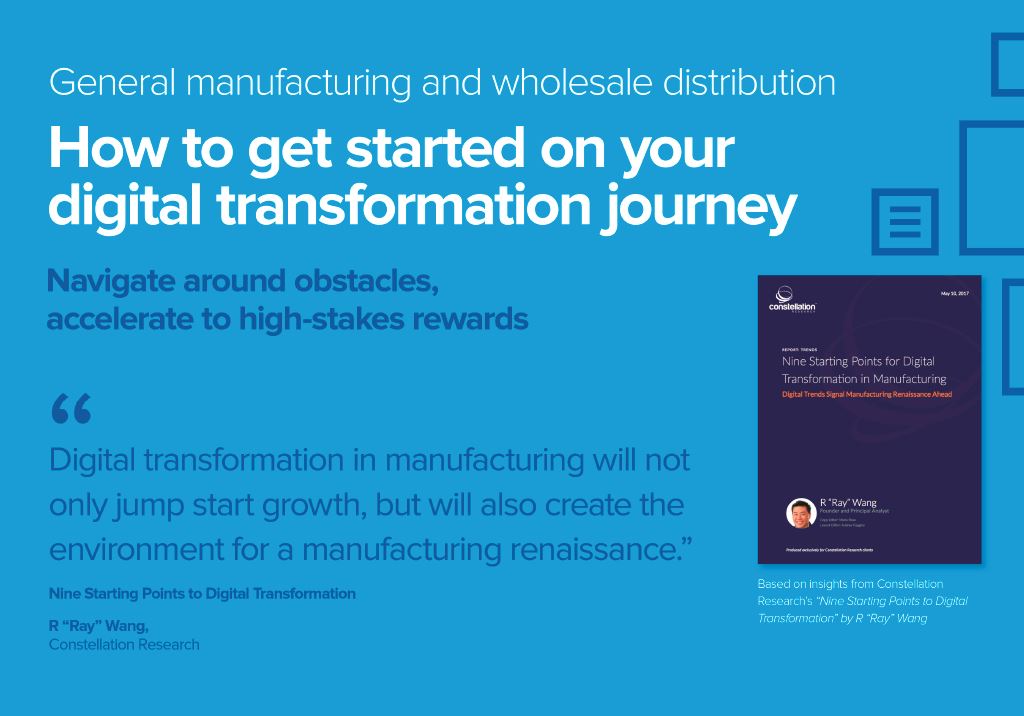While small, agile businesses may have some distinct advantages over larger competitors, they also face their fair share of challenges. Small Business Week (April 29-May 5) provides an opportunity to spotlight those challenges and what can be done to overcome the obstacles. A wide range of stakeholders rely on the success of small businesses. Small job-shops, fabricators, subcontractors, parts suppliers, engineering firms, and niche manufacturers play important roles in the overall economic stability of the industry. We need small businesses to thrive.
Harriet Schneider
Recent Posts
Small Manufacturers Face Challenges; Technology Can Help - Part 2
Topics: Manufacturing, Technology Challenges
An Infographic: How To Get Started On Your Digital Transformation Journey
Topics: Digital Transformation
Honoring Small Manufacturing Businesses; Celebrating 5 Distinct Advantages - Part 1
Small Business Week was in early May and it provided an excellent opportunity to celebrate the high success rate of small businesses in the manufacturing industry, while also offering advice for further growth. In this digital era of fast paced change, small businesses are ideally suited to seize unfolding opportunities. Their nimble nature, ability to make fast decisions, willingness to reinvent business models, and a passion for innovation give small businesses an important competitive advantage.
Topics: Manufacturing, Technology Challenges
Breakthrough Business Models, Part 4: Usage-Based Pricing; Servitization
Dealers have always been focused on service, but today, as manufacturers and equipment management dealers seek to differentiate themselves both are increasingly reliant on services. The services provided by the dealer and manufacturer have become as important to brand loyalty as the equipment itself.
This name for this trend is called servitization and it simply means applying a service to a product in order to create additional value or a new offering to customers.
The servitization of the heavy equipment industry has been evolving for many years. While onboard technology enhanced the performance of single machines, the data it produced was rarely accessed for other purposes. In contrast, today low-cost sensors and wireless technology allow for real time analysis of the data of entire equipment fleets, allowing dealers to extend their offerings to include fleet management and other services. Still emerging is the use of analytics and artificial intelligence to provide additional customer insights.
Topics: Distribution
An Infographic: Consumers Want Supply Chain Visibility And Performance Or They Will Switch Brands
A recent survey conducted by YouGov on behalf of Infor shows that consumers now expect a supply chain visibility solution as part of the brand experience. Download this infographic to learn how consumer expectations are on the rise across all product categories.
Topics: Supply Chain, Supply Chain Visibility
Breakthrough Business Models, Part 3: Asset Sharing
Is equipment-sharing the elephant in the room that traditional dealers and rental firms don’t want to talk about? That’s the view of Frank Manfredi, industry consultant and president of Manfredi & Associates, a consulting firm and publisher of Machinery Outlook.
“People just don’t understand what it could do them,” says Manfredi. He likens the impact of the equipment-sharing model to that of equipment rental which was once a small sector of the industry but now accounts for more than half of the machine inventory. “People were in denial about that, too,” he says.
“There’s excess capacity in the system,” says Manfredi. “Eventually, no one is going to care who owns the equipment, all they want is the hole dug in the ground.”
Topics: Distribution
Thriving in the Age of Amazon: Embedding Yourself In Your Customers’ Business
For a measure of how e-commerce and cloud computing are obliterating old business relationships and creating new, unexpected, and deeper partnerships, look no farther than distributors that are embedding themselves much more deeply in their key accounts’ day-to-day operations.
In times past, the underlying rule of business was that good fences made good neighbors. Customers and suppliers would interact, visit back and forth, and gradually get to know each other’s business needs, wants, and abilities. They would build mutual respect, might eventually become friends, might even get families together for an evening or a special occasion.
But there were still more walls than windows. Business was business, and companies would never have expected direct visibility into each other’s operations.
Topics: Distribution
Breakthrough Business Models, Part 2: Where To Look For Opportunities
Innovative business models are viewed as a way to protect businesses from disruption. Unlike product innovations, multi-dimensional business models are more difficult for competitors to replicate.
According to Soren Kaplan, best-selling author of Leapfrogging and The Invisible Advantage, and co-founder of UpBOARD , one of the first steps for business owners when pursing a new business model should be an assessment of the current industry. “If new competitors are entering the market, if competition is increasingly based on price, if differentiation is harder, you’re in a mature market,” says Kaplan. “This means you’re likely to see business model innovation happen.”
With digital disruption happening in virtually every industry, your choices are to drive it yourself or become the next Blockbuster or Borders.
Topics: Distribution
Thriving In The Age Of Amazon: The Two Most Important Questions
There’s an important question brewing for distributors as big, central supply houses like Amazon continue disrupting the manufacturing and wholesale marketplaces: Is Amazon the biggest and, possibly, the last challenge your business will face, or the best opportunity that will ever come your way?
At first glance, the answer is one or the other, with not very much middle ground.
The Amazon story has been building for years now, and most distributors understand the risk. They’re a big, massively tech-enabled company. For practical purposes, they have unlimited resources. They had a hand in creating the consumer-oriented e-commerce platforms that now set the standard for business-to-business relationships.
And they’re serious about moving in on distributors’ established business relationships and making them their own.
The famous author Douglas Adams had the first piece of universally good advice for anyone facing such a monumental threat: DON’T PANIC. But unless you’re a hitchhiker with the whole universe at your disposal and a consuming need to remember the number ‘42’, that only works if you have a plan in place to respond.
Topics: Distribution
Breakthrough Business Models, Part 1: Why Equipment Dealers And Rental Firms Need Them
Most construction equipment and rental dealers will admit that there is less differentiation between products today, resulting in increasing pressure on prices and lower margins. Parts are available from a proliferation of sellers and it’s easier than ever for customers to shop for the lowest price. Customers want to own less and rent more. We have technology with the potential to improve productivity and profitability for dealers and their customers, yet adoption lags. Why? In a Fast Company article , authors John Elkington and Richard Johnson argue that we need more breakthrough business models, not breakthrough technology.
“Business models are what connects a technology’s potential with real market needs and consumer demand,” says the authors.
Strategy consultant and author Kay Plantes, believes that business models have become a key way to differentiate from the competition, replacing product features and benefits. A business model defines how will you create, deliver and capture value for your customers.
Consider how these innovative business models enabled these companies to differentiate themselves in their markets:
Topics: Rentals & Equipment






